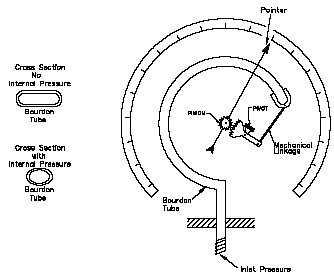Bourdon Tube Pressure Detector Review
Electronics, Instrumentation & Electrical Database
Bourdon Tube Pressure Detector Review
The bourdon tube pressure instrument is one of the oldest pressure sensing instruments in use today. The bourdon tube (refer to Figure A-1) consists of a thin-walled tube that is flattened diametrically on opposite sides to produce a cross-sectional area elliptical in shape, having two long flat sides and two short round sides. The tube is bent lengthwise into an arc of a circle of 270 to 300 degrees. Pressure applied to the inside of the tube causes distention of the flat sections and tends to restore its original round cross-section. This change in cross-section causes the tube to straighten slightly. Since the tube is permanently fastened at one end, the tip of the tube traces a curve that is the result of the change in angular position with respect to the center. Within limits, the movement of the tip of the tube can then be used to position a pointer or to develop an equivalent electrical signal to indicate the value of the applied internal pressure.

Figure A-1